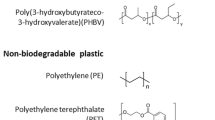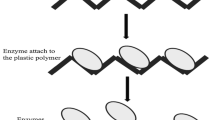Abstract
The use of artificial substratum made out of poly-β-hydroxybutyrate (PHB) based biodegradable plastic for penaeid shrimp culture was investigated for the first time. Provision of PHB substratum consisting of PHB type P209 (Biomer, Krailling, Germany) to postlarval whiteleg shrimp Litopenaeus vannamei (106 ± 52 mg) resulted in significantly higher survival (P ≤ 0.05) of 83.6 ± 3.4% as compared to 73.9 ± 3.0% for postlarvae provided with conventional substratum consisting of polyvinylchloride (PVC) pipes. Results on final weight showed significantly higher weight (P ≤ 0.05) of 1008.2 ± 4.5 mg in postlarval whiteleg shrimp provided PHB substratum as compared to 893.4 ± 30.0 mg for postlarvae provided with PVC substratum. The trends of higher visit and preference by postlarval whiteleg shrimp on 10-day and 70-day aged PHB substrata over 10-day and 70-day aged PVC substrata suggest the importance of PHB substratum as grazing area rather than as shelter. Test conducted on water quality also showed a trend towards higher total ammonia-nitrogen (TAN) conversion from an initial concentration of 1.75 ± 0.0 mg L−1 to 0.35 mg ± 0.04 mg L−1 after 72 h with PHB substratum while using no substratum and PVC substratum lead to TAN concentrations of 1.28 ± 0.06 mg L−1 and 1.23 ± 0.10 mg L−1, respectively. Overall, this study indicates that artificial substratum consisting of PHB-based biodegradable plastic increases the quality of postlarval whiteleg shrimp and that it contributes to maintaining good water quality.




Similar content being viewed by others
Data Availability
All data are available from the corresponding author and can be obtained upon reasonable request.
References
Thompson FL, Abreu PC, Cavalli R (1999) The use of microorganisms as food source for Penaeus paulensis larvae. Aquaculture 174(1–2):139–153
Kautsky N, Ronnback P, Tedengren M, Troell M (2000) Ecosystem perspectives on management of disease in shrimp pond farming. Aquaculture 191:145–161
Arnold SJ, Sellars MJ, Crocos PJ, Coman GJ (2006) Intensive production of juvenile tiger shrimp Penaeus monodon: an evaluation of stocking density and artificial substrates. Aquaculture 261(3):890–896
Zhang B, Lin W, Huang J, Wang Y, Xu R (2010) Effects of artificial substrates on the growth, survival and spatial distribution of Litopenaeus vannamei in the intensive culture condition. Iranian Journal of Fisheries Sciences 9(2):293–304
Zhang J, Chen L, Dong H, Duan Y, Li Z, Wen G, Chen J, Feng Z, Xu W, Xie J (2016) Artificial substrates in zero-water-exchange culture system regulate the rearing performance of Pacific white shrimp Litopenaeus vannamei (Boone, 1931) under the winter indoor condition. Aquac Res 47(1):91–100
Pradeep B, Pandey PK, Ayyappan S (2003) Effect of probiotics and antibiotics on water quality and bacterial flora. J Inland Fish Soc India 35(2):68–72
Azim ME, Wahab MA, Verdegem MCJ, Van Dam AA, Van Rooij JM, Beveridge MCM (2002) The effects of artificial substrates on freshwater pond productivity and water quality and the implications for periphyton-based aquaculture. Aquat Living Resour 15(4):231–241
Tidwell JH, Coyle DC, Schulmeiste G (1998) Effects of added substrate on the production and population characteristics of freshwater prawns Macrobrachium rosenbergii in ponds. J World Aquacu Soc 29(1):17–22
Chen JC, Lei SC (1990) Toxicity of ammonia and nitrite to Penaeus monodon juveniles. J World Aquacu Soc 21(4):300–306
Thompson FL, Abreu PC, Wasielesky W (2002) Importance of biofilm for water quality and nourishment in intensive shrimp culture. Aquaculture 203(3–4):263–278
Ziemann DA, Walsh WA, Saphore EG, Fulton-Bennet K (1992) A survey of water quality characteristics of effluent from Hawaiian aquaculture facilities. J World Aquacu Soc 2 393:180–191
Khatoon H, Yusoff FM, Banerjee S, Shariff M, Mohamed S (2007) Use of periphytic cyanobacterium and mixed diatoms coated substrate for improving water quality, survival and growth of Penaeus monodon Fabricius postlarvae. Aquaculture 271:196–205
Audelo-Naranjo M, Martínez-Córdova LR, Gómez-Jiménez S, Voltolina D (2012) Intensive culture of Litopenaeus vannamei without water exchange and with an artificial substrate. Hidrobiológica 22(1):1–7
Matavulj M, Molitoris HP (1992) Fungal degradation of polyhydroxyalkanoates and a semiquantitative assay for screening their degradation by terrestrial fungi. FEMS Microbiol Rev 9(2–4):323–331
Garcia B, Olivera ER, Minambres B, Fernandez-Valverde M, Canedo LM, Prieto MA, Garcia JL, Martinez M, Luengo JM (1999) Novel biodegradable aromatic plastics from a bacterial source. Genetic and biochemical studies on a route of the phenylacetyl-CoA catabolon. J Biol Chem 274(41):29228–29241
Braunegg G, Lefebvre G, Genser KF (1998) Polyhydroxyalkanoates, biopolyesters from renewable resources: Physiological and engineering aspects. J Biotechnol 65(2–3):127–161
Chang HM, Wang ZH, Luo HN, Xu M, Ren XY, Zheng GX, Wu BJ, Zhang XH, Lu XY, Chen F, Jing XH, Wang L (2014) Poly(3-hydroxybutyrate-co-3-hydroxyhexanoate)-based scaffolds for tissue engineering. Braz J Med Biol Res 47(7):533–539
Nhan DT, Wille M, De Schryver P, Defoirdt T, Bossier P, Sorgeloos P (2010) The effect of poly-β-hydroxybutyrate on larviculture of the giant freshwater prawn Macrobrachium rosenbergii. Aquaculture 302(1–2):76–81
Sui L, Cai J, Sun H, Wille M, Bossier P (2012) Effect of poly-β-hydroxybutyrate on Chinese mitten crab, Eriocheir sinensis, larvae challenged with pathogenic Vibrio anguillarum. J Fish Dis 35(5):359–364
Laranja JL, Ludevese-Pascual GL, Amar EC, Sorgeloos P, Bossier P, De Schryver P (2014) Poly-β-hydroxybutyrate (PHB) accumulating Bacillus spp. improve the survival, growth and robustness of Penaeus monodon (Fabricius, 1798) postlarvae. Vet Microbiol 173(3–4):310–317
Defoirdt T, Halet D, Vervaeren H, Boon N, Van de Wiele T, Sorgeloos P, Bossier P, Verstraete W (2007) The bacterial storage compound poly-beta-hydroxybutyrate protects Artemia franciscana from pathogenic Vibrio campbellii. Environ Microbiol 9(2):445–452
Halet D, Defoirdt T, Van Damme P, Vervaeren H, Forrez I, Van de Wiele T, Boon N, Sorgeloos P, Bossier P, Verstraete W (2007) Poly-beta-hydroxybutyrate-accumulating bacteria protect gnotobiotic Artemia franciscana from pathogenic Vibrio campbellii. FEMS Microbiol Ecol 60:363–369
Thai TQ, Wille M, Garcia-Gonzalez L, Sorgeloos P, Bossier P, De Schryver P (2014) Poly-ß-hydroxybutyrate content and dose of the bacterial carrier for Artemia enrichment determine the performance of giant freshwater prawn larvae. Appl Microbiol Biotechnol 98(11):5205–5215
De Schryver P (2010) Poly-beta-hydroxybutyrate as a microbial agent in aquaculture. PhD thesis, Ghent University, Belgium
Otoshi CA, Montgomery AD, Matsuda EM, Moss SM (2006) Effects of artificial substrate and water source on growth of juvenile Pacific white shrimp, Litopenaeus vannamei. J World Aquacu 37(2):210–213
Faimali M, Garaventa F, Terlizzi A, Chiantore M, Cattaneo-Vietti R (2004) The interplay of substrate nature and biofilm formation in regulating Balanus amphitrite Darwin, 1854 larval settlement. J Exp Mar Biol Ecol 306(1):37–50
Hung OS, Thiyagarajan V, Qian PY (2008) Preferential attachment of barnacle larvae to natural multi-species biofilms: does surface wettability matter? J Exp Mar Biol Ecol 361(1):36–41
Chung H, Lee O, Huang Y, Mok S, Kolter R, Qian P (2010) Bacterial community succession and chemical profiles of subtidal biofilms in relation to larval settlement of the polychaete Hydroides elegans. Int Soc Microb Ecol 4(6):817–828
Ballester ELC, Wasielesky W Jr, Cavalli RO, Abreu PC (2007) Nursery of the pink shrimp Farfantepenaeus paulensis in cages with artificial substrates: Biofilm composition and shrimp performance. Aquaculture 269(1–4):355–362
Bratvold D, Browdy CL (2001) Effects of sand sediment and vertical surfaces (AquaMats™) on production, water quality, and microbial ecology in an intensive Litopenaeus vannamei culture system. Aquaculture 195(1–2):81–94
Ebeling JM, Timmons MB, Bisogni JJ (2006) Engineering analysis of the stoichiometry of photoautotrophic, autotrophic and heterotrophic removal of ammonia-nitrogen in aquaculture systems. Aquaculture 257(1–4):346–358
Burrell PC, Phalen CM, Hovanec TA (2001) Identification of bacteria responsible for ammonia oxidation in freshwater aquaria. Appl Environ Microbiol 67(12):5791–5800
Acknowledgements
The authors highly acknowledge U.J. Hanggi of the Biomer company (Krailling, Germany) for kindly providing PHB type P209.
Funding
This study was funded by the Flemish Interuniversity Council (VLIR). Peter DS is supported as a post-doctoral research fellow of the Research Fund – Flanders (FWO, Belgium).
Author information
Authors and Affiliations
Corresponding author
Ethics declarations
Conflict of interest
The authors declare that they have no conflict of interest.
Rights and permissions
About this article
Cite this article
Ludevese-Pascual, G., Laranja, J.L., Amar, E. et al. Application of Poly-β-hydroxybutyrate (PHB)-Based Biodegradable Plastic as Artificial Substratum in Litopenaeus vannamei Culture. J Polym Environ 27, 1–9 (2019). https://doi.org/10.1007/s10924-018-1315-3
Published:
Issue Date:
DOI: https://doi.org/10.1007/s10924-018-1315-3




